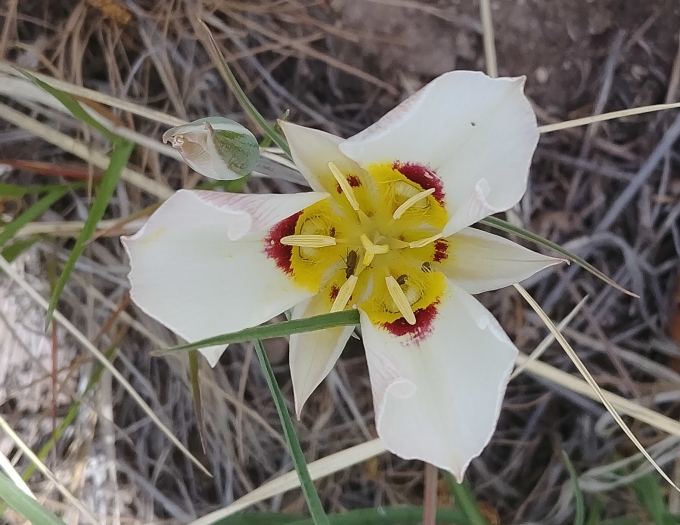Sego Lily
(Calochortus nuttallii)
Sego Lily (Calochortus nuttallii)
/
/

Rolf Lawrenz
CC BY 4.0
Image By:
Rolf Lawrenz
Recorded By:
Copyright:
CC BY 4.0
Copyright Notice:
Photo by: Rolf Lawrenz | License Type: CC BY 4.0 | License URL: http://creativecommons.org/licenses/by/4.0/ | Rights Holder: Rolf Lawrenz | Publisher: iNaturalist | Date Created: 2018-05-22T12:32:16-07:00 |



















































Estimated Native Range
Summary
Calochortus nuttallii, commonly known as Sego Lily, is a deciduous perennial herb that is native to the open meadows, grasslands, and sagebrush deserts of the Intermountain West in the United States. It typically grows to a height of 15–45 cm (6–18 inches) and features linear, grass-like leaves. The Sego Lily is celebrated for its striking flowers, which consist of 1 to 4 blooms per stem, each with 3 white petals (and 3 sepals) that are often tinged with lilac or occasionally magenta. These petals showcase a distinctive purplish band emanating from the yellow base. The plant is most notable for its tulip-shaped flowers that can reach up to 3 inches across and bloom in early summer, offering a showy display.
The Sego Lily is valued for its ornamental beauty and its ability to attract and support native pollinators. It is a popular choice for rock gardens, native plant landscapes, and wildflower meadows. This plant is cold-hardy and requires a deep, sandy soil with good drainage. It thrives in full sun to part shade and prefers low to medium water, making it suitable for xeriscaping. While it is generally easy to maintain, the Sego Lily can be susceptible to root rot if overwatered or planted in poorly drained soils. Propagation is typically done through bulblets, which take two years to flower. Gardeners should be aware that the Sego Lily is not a fast grower, so patience is required when cultivating this plant.CC BY-SA 4.0
The Sego Lily is valued for its ornamental beauty and its ability to attract and support native pollinators. It is a popular choice for rock gardens, native plant landscapes, and wildflower meadows. This plant is cold-hardy and requires a deep, sandy soil with good drainage. It thrives in full sun to part shade and prefers low to medium water, making it suitable for xeriscaping. While it is generally easy to maintain, the Sego Lily can be susceptible to root rot if overwatered or planted in poorly drained soils. Propagation is typically done through bulblets, which take two years to flower. Gardeners should be aware that the Sego Lily is not a fast grower, so patience is required when cultivating this plant.CC BY-SA 4.0
Plant Description
- Plant Type: Herb
- Height: 0.9-2 feet
- Width: 0.5-0.8 feet
- Growth Rate: Moderate
- Flower Color: White
- Flowering Season: Spring, Summer
- Leaf Retention: Deciduous
Growth Requirements
- Sun: Full Sun, Part Shade
- Water: Low, Medium
- Drainage: Fast, Medium
Common Uses
Drought Tolerant, Edible*Disclaimer: Easyscape's listed plant edibility is for informational use. Always verify the safety and proper identification of any plant before consumption., Low Maintenance, Showy Flowers
Natural Habitat
Open meadows, grasslands, and sagebrush deserts of the Intermountain West
Other Names
Common Names: Sego-Lily
Scientific Names: Calochortus nuttallii , Calochortus rhodothecus , Calochortus watsonii
GBIF Accepted Name: Calochortus nuttallii Torr.